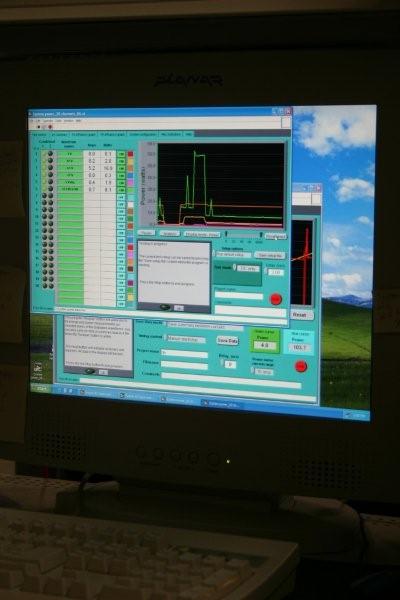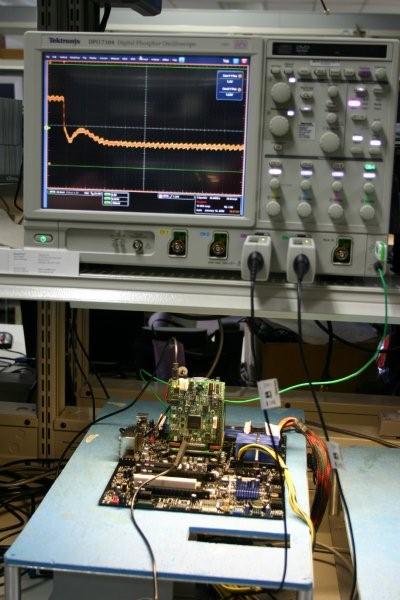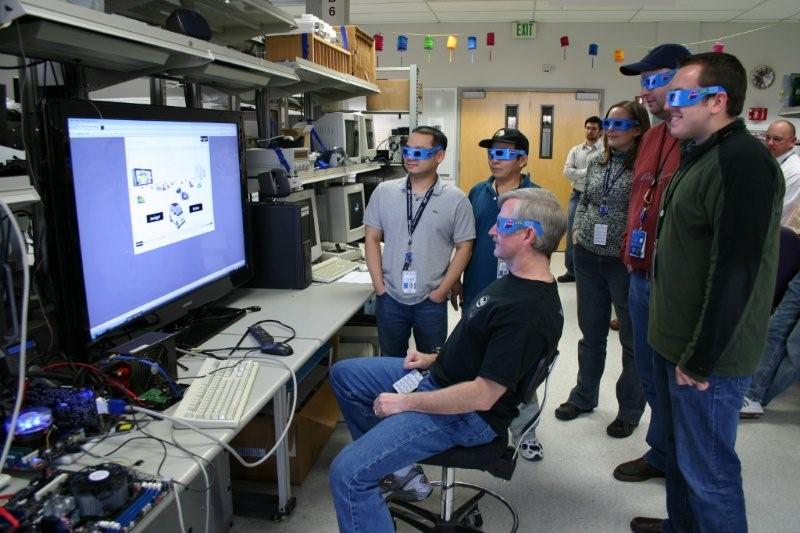Under The Kimono: Inside Intel's Hidden R&D
Testing Power
If you’ve ever looked into quality power supplies, you know the importance of power rails and the loads placed on them. This image shows another test station measuring system power draw across each rail, and you can see when the system went from active into standby. Obviously, a flatline is good. With no flatline, it would mean that the BIOS or drivers were pinging the CPU with unnecessary signals and not allowing it to remain idle. This test also reveals if a platform has any significant power leaks.
Serious Equipment
This Tektronix oscilloscope is measuring voltage stepping, emulating a transient load placed on the CPU by software activity. As you add a load step, the voltage comes down to the low line, and when you do a load release (a low current condition), the voltage should spring back up to where it’s supposed to be. Overshooting this level to near or above the top of the screen could cause CPU reliability issues. Signal drooping below this level often causes blue screen crashes. This screen shows a 100 amp load being placed on the CPU 1,000 times per second, and the readout shows plenty of margin for increasing power levels for overclocking. This particular oscilloscope costs roughly $12,000—not bad in the scope world because CPU frequencies aren’t that high. For data buses, you need scopes like those a few aisles over, with much higher speed thresholds and price tags up to $50,000.
The End Of A Long Day
Perhaps you’ve already spotted Intel’s promo branding on ads for the upcoming 3D animated movie, Monsters vs. Aliens. This wasn’t the time to grill our guides on exactly what facets of Intel technology (as opposed to a marketing deal) make InTru 3D special or different. Honestly, we’re looking forward more to the upcoming InTru 3D episode of NBC’s Chuck. Even more honestly, we don’t know why all of these Intel electrical engineers need 3D glasses. Perhaps it places a different sort of system load than the gaming normally conducted on this luscious Samsung LCD. Or perhaps PR set us up with an irresistible shot to help promote the InTru 3D angle. Hmm.
In any case, we walked out of Hawthorn Farms with a new appreciation for the R&D work that goes into Intel products. We now have a much better idea of why Intel has its reputation for owning some of the most stable boards and processors in the business. Does all of this engineering mean Intel has the fastest products? Not always. But as one guide told us, remember that Intel has only sanctioned overclocking for a couple of years. The company is still getting comfortable with loosening the performance reins. All in all, what we saw gives us hope that the best from Intel is yet to come.
Do other manufacturers have similar R&D facilities? Probably. But we haven’t been invited behind their curtains, and therein is perhaps one of the biggest points. Some Intel products may be manufactured overseas, but a staggering amount of brain power and creativity sits right here in the U.S. We walked among hundreds of Intel employees during this shoot, and this was in just one of Intel’s many buildings scattered across Hillsboro, Oregon. If all other things were equal when deciding on a motherboard, having seen what we’ve now seen, we’d feel good knowing that the foundation of our rig was dreamed up, modified, tested, and unleashed right here at home.
Get Tom's Hardware's best news and in-depth reviews, straight to your inbox.
-
randomizer "In this test setup, the chassis gets hit with 25 G and the installed card with 50 G."Reply
Now that's quality control! -
Pei-chen Intel should move on to solid state (Japanese) capacitors. Better parts are better parts even if they are equally reliable in desktop environment.Reply
BTW, that “dark room” looks great. My office is too well lit.
-
enterco They may have good testing environment, but it seems that it's used only for 'select' motherboard/chipset combinations. For example, they don't test Core2 E7xxx CPU's in combination with x965 chipsets. Anyway, x965 boards should be able to use all Core 2 Processors with 1066 MHz.Reply
The conclusion: why bother to test and certify such an old motherboard chipset, as long there are so many testers out there?
-
curnel_D TheCapuletAhh, so this is what Toms got for this article: http://www.tomshardware.com/review ,2138.htmlProbably. Lol. But at least it was worth the cool look into Intel.Reply -
So, if Intel is so great then, what happened with the X38, X48, and X58?Reply
All three performance Intel boards "suck"......X975 was a great motherboard, however it has been very average since.....Has Intel ever thought to use a "solid capacitor" motherboard for the Extreme tine of boards? What gives with the Intel board? Anyway they need an enthusist level bios such as Gigabyte, Evga, Asus, or Dfi anyway.....Greatest Cpu and Chipset combination around, however the MOBO's suck wind.......Mr. Bad Kat......... -
Area51 ReplyThey may have good testing environment, but it seems that it's used only for 'select' motherboard/chipset combinations. For example, they don't test Core2 E7xxx CPU's in combination with x965 chipsets. Anyway, x965 boards should be able to use all Core 2 Processors with 1066 MHz.
The conclusion: why bother to test and certify such an old motherboard chipset, as long there are so many testers out there?
You sir are an idiot. -
enterco I believe you are wrong. There are few facts:Reply
1. Intel claims that their boards, specifically DG965OT can be used with 'Core 2 Processors with 1066 MHz FSB' (check this link)
2. Intel has made the Core2 E5xxx and Core2 E7xxx processors with lower FSB than E8xxx series, and these CPU's FSB are 1066, and 800 MHz, but their statement is that 45nm CPUs are compatible with 3x series chipset and later. Perhaps, a good reason to make these variants of Wolfdale is to make them available for older chipsets. But that's true only for other vendors' boards.
3. Intel's CPU compatibility tool claims that Core2 E7xxx (1066 MHz) cannot be used with DG965OT motherboard. This can be checked here.
4. Intel's support specialists from the agree that 'this combination is not tested'
5. Since I've asked them any details, Intel didn't update their DG965OT product specification page, and they did not include any statement regarding Wolfdale series Core2duo processors
Now, how can anyone explain that a motherboard which can be used with 'Core2 processors with 1066 MHz' cannot be used with Wolfdale-derived Core2s? The only answer I found is: they don't have enough resources to waste TESTING a combination whch seems to be valid; or they are interested in selling only the new motherboards, so a customer won't upgrade only the CPU.
Best regards, -
anonymous user enterco.Reply
Is your motherboard tested to work with every DDR3 memory vendor, every SATA HDD model, every PCI-e Video card? - NO -
As long as Motherboard and components meet common electrical specifications - they should work fine.
Functional testing usually covers some common components as a sanity check, but never every possible combination (that would be a waste of resources).
As long as motherboard and CPU meet common spec (and CPU is supported by BIOS) the combination should work, even if it is "untested"
In the end, that is the whole purpose of having electrical specificion for components.


